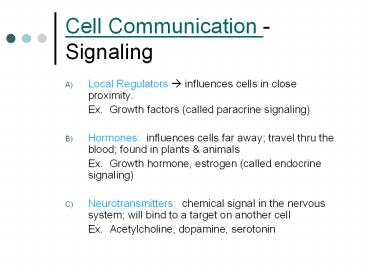Cell Communication - Signaling - PowerPoint PPT Presentation
1 / 22
Title:
Cell Communication - Signaling
Description:
Title: Unit 2: Cell Structure & Function Author: Bethany J. Little Last modified by: BETH WALKER Created Date: 9/5/2005 3:10:59 PM Document presentation format – PowerPoint PPT presentation
Number of Views:146
Avg rating:3.0/5.0
Title: Cell Communication - Signaling
1
Cell Communication - Signaling
- Local Regulators ? influences cells in close
proximity. - Ex. Growth factors (called paracrine signaling)
- Hormones influences cells far away travel thru
the blood found in plants animals - Ex. Growth hormone, estrogen (called endocrine
signaling) - Neurotransmitters chemical signal in the
nervous system will bind to a target on another
cell - Ex. Acetylcholine, dopamine, serotonin
2
Cell Communication - Signaling
- Local Regulators ? influences cells in close
proximity. - Ex. Growth factors (called paracrine signaling)
- Hormones influences cells far away travel thru
the blood found in plants animals - Ex. Growth hormone, estrogen (called endocrine
signaling) - Neurotransmitters chemical signal in the
nervous system will bind to a target on another
cell - Ex. Acetylcholine, dopamine, serotonin
3
Cell Communication - Signaling
4
Cell Communication Direct Contact
- Cells may chose to communicate through direct
contact, instead of sending a messenger - 1) Tight Junctions
- 2) Gap Junctions
- 3) Desmosomes
- 4) Plasmodesmata (plants only)
5
Cell Communication Direct Contact
6
Three Stages of Cell Signaling
- Reception target cell detects the incoming
signal - Ex. Signal may bind to a protein (on membrane)
- Transduction when the signal is changed to a
form/message that can bring about a
response/change. - Ex. Usually involves a complex pathway, may
cause amplification of the message - Response any activity that occurs as a result
of the - signal
7
Overview of Cell Signaling
8
Reception of the Signal
- Recognition b/w signal receptor by shape (lock
and key) - Most receptors are peripheral/integral proteins
(in cell membrane) - Signal is a ligand ? small molecule that binds to
a big molecule (receptor protein)
9
Signal Molecules
- Examples of Signal Molecules are .
- A) Receptors on Cell Membrane
- 1) G Protein-Linked Receptors
- neurotransmitters, embryonic development,
- vision, smell, bacterial
infections (Figure 11.7) - 2) Tyrosine-Kinase Receptors activate many
- signal-transduction pathways
(Figure 11.8) - 3) Ion-Channel Receptors - ligand binds
- changes ion concentration, which
results in a - cellular response (Figure 11.9)
- B) Receptors that Pass into Cell called
Intracellular - Receptors (Figure 11.10)
10
G Protein-Linked Receptor
11
Tyrosine-Kinase Receptor
12
Ion-Channel Receptors
13
Intracellular Receptors
14
Transduction of the Signal
- Usually involves many steps/pathway
- May involve amplifications (many molecules are
activated) - Proteins involved may be activated by adding a
phosphate group ? phosphorylation - Phosphorylation changes protein shape
15
Protein Phosphorylation
- Protein Kinase an enzyme that transfers P
groups from ATP to a protein - Many relay molecules in a signal-transduction
pathway are protein kinases ? creates a cascade
of phosphorylation (Figure 11.11) - About 1 of our genes code for protein kinases
- Abnormal protein kinase activity could lead to
cancer - Protein Phosphatases ? enzymes that remove
phosphate groups from proteins (opposite of
protein kinases)
16
Protein Phosphorylation Cascade
17
Second Messenger
- Small, non-protein, water-soluble molecule or ion
that may carry signals via diffusion into and
through a cell - Involved in both G protein-linked receptor
tyrosine-kinase receptor pathways - Two common secondary messengers are
- 1) Cyclic AMP G protein-linked receptors
- 2) Calcium Ions (2) neurotransmitters,
- growth factors, some hormones
18
Cyclic AMP Secondary Messenger
- Cyclic Adenosine Monophosphatte
19
Calcium Ions Inositol Triphosphate Secondary
Messenger(s)
- Calcium is in low concentration in the cytosol,
high concentration in the blood, high
concentration in the ER (actively pumped into ER
via protein pumps)
20
Cellular Responses
- May regulate..
- 1) Synthesis of Protein/Enzyme -- by
- turning genes on and/or off via
- transcription (Figure 11.17)
- 2) Activity of Proteins/Enzymes in the
- cytoplasm
21
Cellular Response Regulation via Transcription
22
Multiple Steps in Signaling Pathways act to.
- Amplify the Response few signal molecules can
lead to the release of many molecules at the end
of the pathway - Specify Signaling Different kinds of cells have
different proteins therefore, a cells detection
response to a particular signal depends on its
collection of proteins































